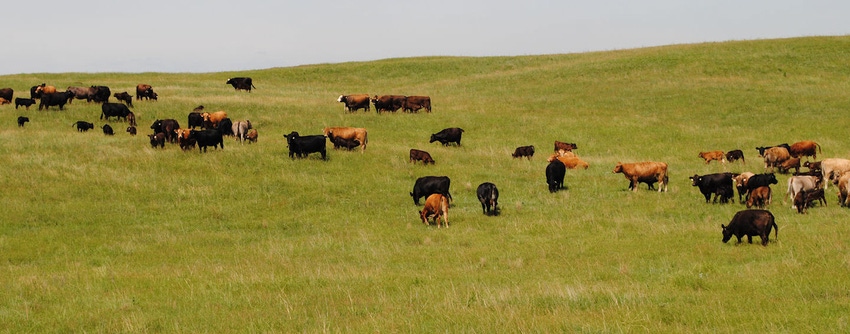May 4, 2016

Providing protein and energy requirements to beef cattle with standing forage is an economical way to operate the ranch. Hay and supplements are expensive and can erode profitability. This erosion can be avoided in most geographical regions of the United States by managing cool season and warm season forages for year round grazing.
Late fall and early winter grazing
“Forage stockpiled in late summer can provide late fall and winter grazing,” explains Dr. John Jennings, University of Arkansas. “Stockpiling forage is the practice of accumulating forage growth intended for grazing in a later season. During the spring and summer, stockpiling is seldom advantageous, except during severe drought. Forages mature and are of low quality due to stem and seedhead production in the warmer months. Cool night temperatures and shorter days of late summer and fall tend to reduce forage fiber content, thus promoting leafy, high quality forage.”
“Tall fescue and bermudagrass are the most commonly stockpiled forages, but bahiagrass and dallisgrass have also been stockpiled successfully,” Jennings continues. “Other forages may produce good fall growth but then deteriorate quickly. Some forage, such as crabgrass, is excellent quality during the growing season, but becomes unpalatable. It degrades quickly after a killing frost and is often refused by cattle.”
Jennings recommends specific steps for increasing the likelihood of having good stockpiled forage growth.
Late winter and early spring grazing
“Healthy stands of cool-season grass/legume mixtures can help extend winter grazing until enough summer forage is available,” says Rocky Lemus, Mississippi State University. “You can seed arrowleaf, berseem and crimson clovers in the fall with annual ryegrass or small grains. Producers often plant annual ryegrass and/or small grains with crimson clover because of cost and availability, but arrowleaf and berseem are better choices. As you move away from the Gulf into cooler temperatures, a combination of white clover and tall fescue works well.”
“You must know how to establish and manage annual forages to maintain successful winter pastures,” cautions Lemus. “Availability of winter forage depends on a number of environmental conditions, like rainfall and temperature. Seeding rates, planting methods and fertilization also affect when, how much, and how often the established forage can be grazed.”
Brassicas such as kale, forage rape, turnips and swedes can help extend the grazing season. They are high-quality, high yielding and fast growing forage crops that are suitable for livestock grazing during early winter and spring.
Late spring, summer and early fall grazing
“Many forage options are available for grazing during the warm parts of the year,” says Jennings. “Warm season annual grasses such as sudangrass, sorghum sudangrass, pearl millet and others will be very productive during mid-summer. All of these can provide pasture as early as 45 days after seeding. Sudangrass and sorghum sudans have prussic acid poisoning potential when grazed less than 18 inches tall or after a frost. Pearl millet does not have prussic acid poisoning potential.”
“Warm season perennial grasses are either introduced or native species,” Jennings continues. “Introduced warm season forages include the old world bluestems (OWB) and bermudagrass. Old world bluestems are so called because they came from the Caucasus region of Russia. OWBs are hard to establish because the seed is low in vigor.
“Native warm season grasses include switchgrass, big bluestem, little bluestem, indiangrass and eastern gamagrass. All these grasses must be rotationally grazed and rested in the fall for persistence.”
Each producer needs to assess forage production capability of his or her land and choose feeding practices that best fit the economics of their type of operation.
About the Author(s)
You May Also Like




